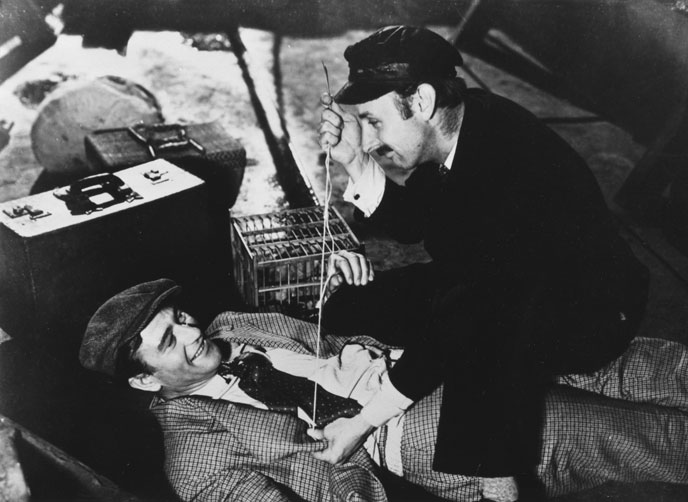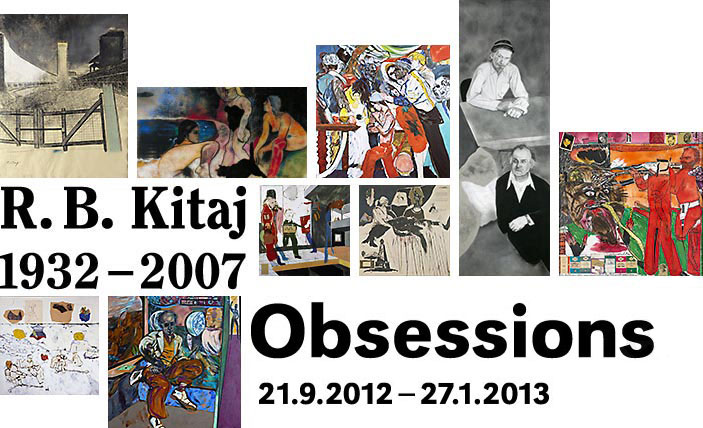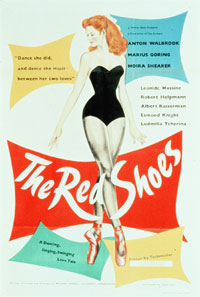Film series accompanying the exhibition at the Jewish Museum Berlin
Throughout the duration of the exhibition and as a part of "Monday Movies," the Jewish Museum Berlin screened a documentary about Kitaj, as well as some of his favorite films:
Kitaj… In the Picture
by Jake Auerbach
UK 1994, 40 mins, in English (original version)
Throughout his life, R.B. Kitaj was reluctant to let himself be captured on camera, despite his prolific outspokenness on the page. "I'm the least spontaneous of men," he explained, borrowing from Degas.
Kitaj finally relented in 1994 and allowed himself to be filmed by Jake Auerbach, the son of his long time friend and fellow School of London painter Frank Auerbach. What followed is a rare and candid glimpse into Kitaj's childhood, his works, and his development into one of the most celebrated painters of his time.
The Long Voyage Home
by John Ford
USA 1940, 105 mins, in English (original version)

-
"The Long Voyage Home" by John Ford (filmstill)
© Bildarchiv/Deutsches Filminstitut-DIF e.V.
"John Ford made a swell movie called The Long Voyage Home about the loneliness of the seafarer," Kitaj wrote, "which still makes me cry as I approach 70." Adapted from four plays written by Eugene O'Neill and starring John Wayne, The Long Voyage Home follows the crew aboard the British cargo ship SS Glencaim on a journey from the West Indies to Baltimore during World War II. Kitaj himself joined a Norwegian freighter at the age of seventeen, and often used Ford's film to relate to his experience.
The Red Shoes
by Michael Powell
UK 1948, 133 mins, in English (original version)
When "The Red Shoes" opened in theatres in 1948, Kitaj described himself as "its most rapt teenager." Directed by Michael Powell, who would later have his portrait painted by Kitaj, "The Red Shoes" is based on the fairy tale by Hans Christian Anderson.
The film follows a young dancer, played by Moira Shearer, who is torn between her desire to become a prima ballerina and her love for Julian, a young composer. A story about the struggle between love and art, Kitaj explains, "The Red Shoes set me dreaming what an artist's life might be like."
Ride Lonesome
by Burt Boetticher
USA 1959, 73 mins, in English (original version)
"Ride Lonesome", the classic Western directed by Burt Boetticher, is frequently cited by filmmakers and critics such as Martin Scorsese for its exceptional narrative technique. Randolph Scott stars as a bounty hunter charged with escorting a wanted outlaw to Santa Cruz, where he awaits justice. Kitaj combined stills from "Ride Lonesome" with his impressions of CÚzanne's "Bathers" as inspiration for his 1994 painting "Western Bathers".
She Wore a Yellow Ribbon
by John Ford
USA 1949, 103 mins, in English (original version)
John Ford's "She Wore a Yellow Ribbon", the second instalment in his Cavalry Trilogy, was a huge commercial success upon its release in 1949. The film takes place directly after Custer's Last Stand, when a retired Captain played by John Wayne embarks on a mission to prevent a massive Indian attack.
Kitaj captures a scene from this film (which he calls a "holy icon" of his) in his painting "The Ohio Gang," in which a girl with a yellow ribbon is courted by two suitors.
The Sun Shines Bright
by John Ford
USA 1953, 90 mins, in English (original version)
When Kitaj made a portrait of his favourite director, "John Ford on his Deathbed," he painted a still from The Sun Shines Bright on the wall above his bed. A remake of Ford's earlier film Judge Priest, the film follows the story of a judge struggling to reconcile racial tensions in turn of the century Kentucky and to win a race for re-election against his right-wing opponent. Though it never achieved much commercial success, John Ford often referred to The Sun Shines Bright as the best of his own films.
The Third Man
by Carol Reed
UK 1949, 104 mins, in English (original version)
In Carol Reed's iconic film noir "The Third Man", a young writer travels to Vienna and enters into a web of suspense as he investigates the mysterious circumstances of a friend's death. With a cast that includes Joseph Cotten, Orson Welles and Alida Valli, "The Third Man" was written by Graham Greene and remains highly regarded today for its expressionist cinematography, soundtrack and its depiction of shadowy post-war Vienna. Kitaj credits the film with influencing him to leave America and study art in Europe.



